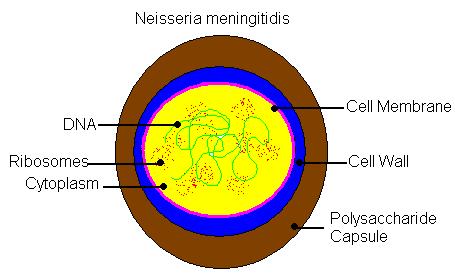Neisseria meningitidis and Meningitis
Also known as Meningococcus, it is a Eubacterium best known for causing meningitis in humans.
Meningitis:
formally defined by when the protective membranes surrounding the central nervous system become inflamed. These membranes are known as the meninges.
The meninges of the central nervous system are the following: Dura matter, arachnoid and pia matter as shown in the picture.
Niche, Habitat and infection
Ecological Niche
Neisseria Meningitidis makes its home exclusively in humans as a pathogen, it infects no other living organisms.
Habitat
Its natural habitat is found within the nasopharyngeal tract of humans, as many as fifteen percent of the population carry the bacterium in its non pathogenic form.
Infection
Transmission of Bacteria
Bacteria can be transmitted through throat and respiratory secretions (i.e. Kissing, coughing, sharing drinks and food)
Process of infection
If pathogenic, the bacteria will make its way into colonizing the nasopharynx, or the upper portion of the throat. After colonizing, the bacteria will adhere topili and cross through the nasopharyngeal epithilium by the process of endocytosis. After the bacteria have entered the circulatory system they will adapt to the host environment. It can infect numerous parts of the hosts tissue, but in acute cases much of the bacteria will make its way to the meninges in the brain. Once in the meninges of the brain the bacteria will follow its life cycle and as a product release Lipopolysaccharide, a molecule that promotes pro-inflammatory cytokines, and will cause the meninges to inflame, or meningitis.
Symptoms
The common symptoms of Neisseria Meningitidis can be fatigue, fever, headache, vomiting and neck stiffness, though, they can rapidly progress to seizures, coma or even death. Death occurs in approximately ten percent of cases.
An uncommon yet all the more dangerous symptom of Neisseria Meningitidis is a purpuric rash. This symptom is often overlooked, yet people who exhibit the purpuric rash with meningitis have a fifty percent mortality rate.
Diagnosis
To diagnose, a doctor will obtain a CSF (cerebral spinal fluid) sample and will have it sent to a lab for growth and chemical analyzes. The sample is obtained through a spinal tap in which a needle is inserted into the lower back portion of the spinal cord.
Treatment
Immediately upon suspicion of bacterial meningitis a patient will be put on intravenous antibiotics
Structure and Anatomy
It is a gram-negative diplococcal bacterium. an actual example is shown by the picture below:
It is aerobic and a heterotroph. It also has a polysaccharide capsule.
A polysaccharide is a complex carbohydrate , it is made up of polymers which are made up of many monosaccharides, as shown by the example:
The polysaccharide plays many important roles in the bacterium’s life style, it acts as a barrier between the environment and the cell wall, it mediates host-pathogen interaction and it helps the cell adhere to the host’s cells and tissues, which helps it in turn to infect the host.
Here is a diagram of Neisseria meningitidis:
-
Recent
-
Links
- www.wikipedia.org (endocytosis)
- www.wikipedia.org (Neisseria Meningitidis)
- www.brown.edu (Neisseria meningitidis)
- www.wikipedia.org (Epithelium)
- www.wikipedia.org (Lipopolysaccharide)
- http://jac.oxfordjournals.org (Neisseria meningitidis)
- www.wikipedia.org (Polysaccharide)
- www.cdc.gov (meningococcas)
- www.cas.muohio.edu (general microbiology)
-
Archives
- February 2008 (3)
-
Categories
-
RSS
Entries RSS
Comments RSS




